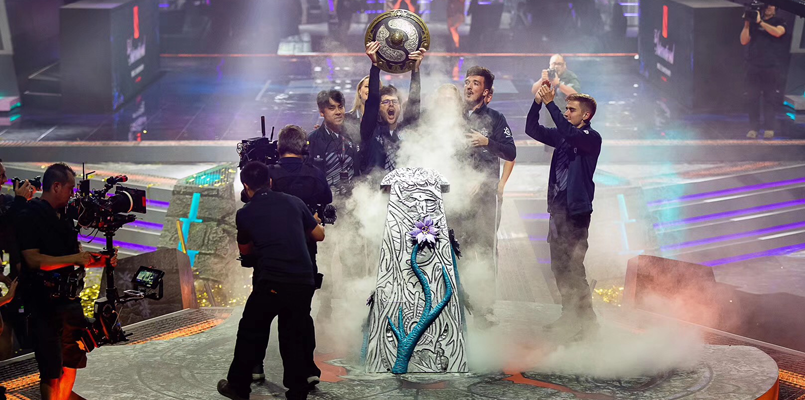Mentioned in this article
Dota 2’s premier world championship event, The International, helped Valve’s multiplayer online battle arena (MOBA) game produce the most hours watched of any game in a single week so far this year with 34M. However, overall the event didn’t generate as much viewership on Twitch as it did last year across August 15-25.
This year, Dota 2 had 46.3M hours watched on Twitch from August 15-25. While that figure is strong, it is a notable decline of 10% from viewership of the game last year during TI8, when Dota 2 had 51.6M hours watched across the same spread of dates.
The drop in viewership overall comes in large part from a decline in Russian-language channels’ hours watched totals. The primary channel for Russian-language coverage of The International this year produced 14.5M hours watched, down 16.1M hours watched in 2018.
The second and third channels covering the event in Russian saw dips to 809K hours watched and 664K hours watched, respectively. That figure was also down from 2018 when the channels had 1.1M and 866K hours watched.
The decline in hours watched on TI’s top Russian-language channels was paired with a drop in average viewership for the channels. The main Russian-language channel averaged 57K concurrent viewers this year, down from 69K CCV last year.
A drop in Russian-language viewership at TI this year came following an early exit by the last-standing team hailing from the Commonwealth of Independent States (CIS), Virtus.pro. While last year, the team was eliminated in the fourth round of lower-bracket play during the double-elimination portion of the finals week. This year, the team was eliminated in just the second round of lower bracket play with a less-than-competitive 0-2 record during the main event.
Another notable explanation for a change in viewership for the event could be that the time zones in which the event was played were vastly different from last year. In 2018, TI was played at Rogers Arena in Vancouver, Canada, but this year, the event took place in Shanghai making viewing matches more difficult for people in some portions of the world.
It wasn’t just Russian-language viewership that experienced a decline this year, though. The main English-language channel for TI also saw a drop in viewership, but its decline wasn’t quite as pronounced as that of the Russian-language channel.
This year, the main channel for TI recorded 18.1M hours watched from August 15-25, down from 18.8M hours watched in 2018. However, the channel’s average CCV of 78K during that timeframe was actually up from 63K CCV in 2018.

Though technically the channel experienced a decrease in hours watched overall, the figure can be seen as more of a stagnation than anything when you factor in the channel’s increase in average CCV. As many esports continue to see audience growth, stagnation isn’t ideal, but it is certainly not as much of a negative as the decline seen by Russian-language Dota 2 coverage of the TI this year.
Meanwhile, the grand nature of The International as one of esports’ prized championships showed that it is still growing in some ways, despite overall viewership being down. For the final broadcast of the event, the main English and Russian-language channels for coverage reached a peak of 482K and 452K CCV, respectively. The figure is an increase from last year when the same channels peaked at 397K and 283K CCV, respectively, during their final broadcasts.
Despite overall viewership for the entirety of the 10-day event falling short of last year’s numbers, the finale on August 25 saw an increase year-over-year with the English and Russian-language channels generating 312K and 234K CCV averages, respectively, up from 272K and 202K CCV.
To put that into perspective, the grand finals on Twitch producing year-over-year growth in viewership is like if the NFL playoffs saw a dip in year-over-year ratings, but then the Super Bowl experienced its largest audience ever.
In the end, the takeaway is that perhaps The International may not have the same room for growth that a lot of other smaller esports events have in terms of overall audience. However, the massive appeal of TI to casual fans has allowed the grand finale to reel in more viewers than last year.
Though many fans of esports know about The International, their interest in the event is less embedded in the nitty-gritty of every match throughout the event. Much like a casual sports fan who doesn’t follow football religiously, the growing audience for esports wants to watch the “Super Bowl” of Dota 2, but they may not care as much about the playoffs as a whole.

